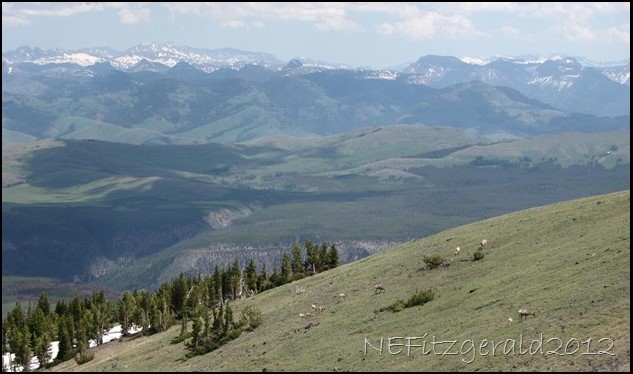“The West of which I speak is but another name for the Wild; and what I have been preparing to say is, that in Wildness is the preservation of the World.”
(from Walking, by Henry David Thoreau)
 |
| View from Mt. Washburn of bighorn sheep and the Absaroka Range |
With the stroke of a pen, on March 1st, 1872 President of the United States Ulysses S. Grant signed into law legislation creating the first national park in what was even then known as the Yellowstone. This act completed the evolution of what over time came to be known as “the park idea.” But evolution did not come about overnight.
From Persians to Puritans
The concept of parks is as old as the hanging gardens of ancient Babylon and the verdant royal gardens of Persian kings. The wonder inspired by these magnificent regal preserves gave to the English–speaking world our word paradise, a place of perfect happiness.
Alexander the Great took over the Persian royal gardens, and eventually the park idea passed from the Greeks into the world of the Romans. When the Duke of Normandy showed up to conquer England in 1066, the “commonality” of land or group use had existed under British folk law for some time. When more and more fertile, arable land passed out of common use the villagers retained “rights of common” on waste land. This land was available to them for pasturage and obtaining fuel and building materials.
But the times, they were a’ changing.
Colonists settling New England carried the idea of commons with them to the New World. In 1634 Boston Commons was created but served a different purpose, serving both as military drill grounds and as fair grounds during harvest time. It became a frequent gathering place of itinerants and traveling shows and also a focal point for lively civil disorders.
However, Puritan attitudes of the time equated idleness with wickedness. The puritanical ethic thus led to an avoidance of all things gay and frivolous and fun. In 1620 nature was considered “a hideous and desolate wilderness, full of wild beasts and wild men” that needed to be struggled with and vanquished according to those biblical injunctions that people were so fearful of not obeying. In somber Puritan communities, recreation was not tolerated.
Along Came the Romantics
During the eighteenth century a philosophy developed which had literary voices praising a love of nature. Out of a concept of the “noble savage” existing happily and contented in his wilderness setting came an upsurge of admiration for nature and a sentimental regard for things that were considered primitive. The Romantic Movement was based on the oneness of Nature, and it would forever influence and transform the American view of nature.
The Romantic viewpoint had many voices – Rousseau, Goethe, Wordsworth, Byron, Keats – but what was missing in order to move any vague parks idea forward was a sense of purpose. This purpose was supplied early in the nineteenth century by philosophers such as Longfellow, Thoreau, and Emerson. Theirs was a transcendentalist point of view.
The Natural World
The transcendentalist’s perception of their world was based on the change that the industrial society was making on the landscape. Squalid factory towns had taken the place of pastoral villages. Urban poverty, misery, and crime had replaced a more slowly moving rustic life. The solution to this degradation was a return not to primitivism but to wondrous nature. Society could limit the unwholesome influences of civilization by keeping closely in touch with the natural world.
Americans readily embraced this concept of nature as beautiful and restorative rather than unforgiving and fearsome. Imperceptibly the ideas of the transcendentalists passed into general acceptance. Literature with an outdoor theme became popular while the Hudson River school of painting took its subjects from landscapes. People desired to visit scenic places. With advances in public transportation such leisure–time activities as walking tours, camping, fishing, and vacation travel became not only feasible but respectable.
Central Park and Yosemite Valley
The park idea progressed in this climate of acceptance. In 1851 Frederick Law Olmsted was appointed to supervise the construction of Central Park in New York City. In 1864 President Lincoln signed legislation giving a grant to the state of California of the Yosemite Valley and the Mariposa Big Tree Grove.
This act did not establish a national park. But it did provide for Yosemite and Mariposa to be used for non–utilitarian purposes and in doing so launched a foundation for the eventual preservation of the Yellowstone region.
Oldest & Best
The earliest suggestion for preserving the Yellowstone region and its thermal wonders came in 1865 by the acting governor of Montana Territory. In late 1869 a second suggestion for preservation in the public interest was offered by one David E. Folsom. During the summer he had led the first organized expedition into the Yellowstone and returned with a much improved map of the region and recommendations for further explorations.
A third suggestion supposedly offered around a geyser basin campfire in 1870 seemed to imply a state grant similar to that of Yosemite, but a fourth suggestion leaves no doubt as to its author’s intent: “Let Congress pass a bill reserving the Great Geyser Basin as a public park forever…”
Unsurprisingly, the Northern Pacific Railroad had also been lobbying enthusiastically for promotion of a park project.
A Bozeman newspaper called for a grant of the region to Montana Territory (disregarding the pesky fact that what they wanted lay mostly in Wyoming). Legislators shrewdly concluded that the only way to preserve Yellowstone and withhold it from settlement and private development would be to place it completely under control of the federal government.
Consequently it happened that after swiftly passing both houses of Congress, Senate bill 392 creating our first national park was signed into law by President Grant on March 1, 1872. From the gardens of ancient kingdoms through English villages holding lands “in common,” through philosophical and economic developments of nineteenth–century New England and beyond, through landscaped city parks and grants to a state, the evolution of the park idea had come full circle.
And although the future of this “new creation” was not immediately apparent to its nineteenth–century designers, with time came a certain realization of its inherent worth within the varied landscapes of our rapidly changing world.








